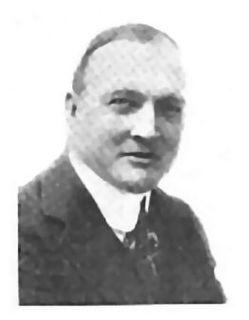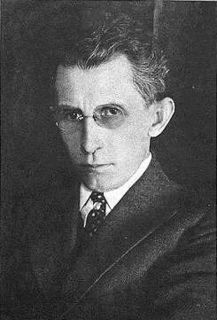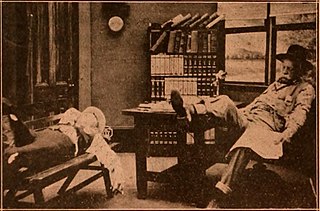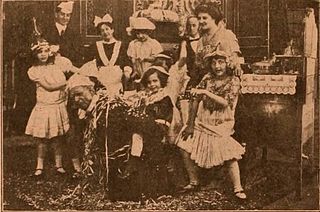The Independent Moving Pictures Company (IMP) was a motion picture studio and production company founded in 1909 by Carl Laemmle. The company was based in New York City, with production facilities in Fort Lee, New Jersey. In 1912, IMP merged with several other production companies to form Universal Film Manufacturing Company, later re-named Universal Pictures Company with Laemmle as president.

Francis "Frank" J. Grandon was an American silent film actor and director who acted in almost 100 films and directed over 100. Frank Grandon's obituary, printed in newspapers from coast-to- coast, called him "the father of movie serial motion pictures" and a mentor to many young film stars.

Thomas B. Ricketts was an English-born American stage and film actor and director who was a pioneer in the film industry. He portrayed Ebenezer Scrooge in the first American film adaptation of A Christmas Carol (1908), and directed one of the first motion pictures ever made in Hollywood. After directing scores of silent films, including the first film to be released by Universal Pictures, Ricketts became a prominent character actor.

James Searle Dawley was an American film director, producer, screenwriter, stage actor, and playwright. Between 1907 and the mid-1920s, while working for Edison, Rex Motion Picture Company, Famous Players, Fox, and other studios, he directed more than 300 short films and 56 features, which include many of the early releases of stars such as Douglas Fairbanks, Mary Pickford, Pearl White, Marguerite Clark, Harold Lloyd, and John Barrymore. He also wrote scenarios for many of his productions, including one for his 1910 horror film Frankenstein, the earliest known screen adaptation of Mary Shelley's 1818 novel. While film direction and screenwriting comprised the bulk of Dawley's career, he also had earlier working experience in theater, performing on stage for more than a decade and managing every aspect of stagecraft. Dawley wrote at least 18 plays as well for repertory companies and for several Broadway productions.

The Immortal Alamo is an American silent film released on May 25, 1911. The Immortal Alamo is the earliest film version of the events surrounding the 1836 Battle of the Alamo. The film was directed by William F. Haddock, and produced by Gaston Méliès. The film's cast included Francis Ford, Edith Storey, William A. Carroll and one hundred cadets from the Peacock Military Academy. The film was said to be 10 minutes in length, and focused on "pretty girl, shy hero, and a villain" formula during the battle.
The Honor of the Family is a 1912 American silent short drama film produced by the Rex Motion Picture Company. The film is a melodramatic one between two brothers and a woman named Marja. Gerald admires the girl and warns his visiting brother, Claude, to leave her alone. Infatuated, Claude and Marja secretly marry before Claude returns to England with a promise to return for her. As the months pass, Marja becomes broken-hearted and attempts suicide, but ends up crippled for life. Claude dies and Gerald cares for Marja, even forging a letter to keep her spirits up. Marja comes to love Gerald and all is revealed on a later date.
Across the Plains is a 1911 American silent Western film directed by Broncho Billy Anderson and Thomas H. Ince and starring Anderson. The film's plot has Jennie Lee and her father heading to California in a prairie schooner. Jennie Lee's father becomes intoxicated before Indians attack them for trespassing on the land. Unable to convince her father to get in the carriage, Jennie Lee flees and races the Indians and is led to a deserted shack by a cowboy as his partner heads off for aid. The two are saved as the ranchmen return and disperse the Indians. The film was not released with a cast of credits as typical of its production era. The production took place on the Miller Brothers 101 Ranch and was released under the Essany label. The completed film was approximately 990 feet in length and was met with mixed reviews. The film's status is unknown, but likely lost.

The Mummy is a 1911 American short silent film produced by the Thanhouser Company. The film details the story of Jack Thornton, a businessman, who is in love with Professor Dix's daughter. Jack purchases a mummy and plans to win his respect as an Egyptologist, but the mummy is reanimated in Jack's room by a live electrical wire. The mummy takes immediate interest in Jack, but is rejected and mummifies him. Before Professor Dix can cut up the now-mummified Jack, she returns and saves him. Jack explains everything and the film concludes with Professor Dix marrying the mummy.

Adrift is a 1911 American silent short drama film produced by the Thanhouser Company and directed by Lucius J. Henderson. The film depicts a story of a young artist whose lack of success leads him to attempt suicide. Before he can carry out the act, his daughter follows and stops him. He confesses to his wife and she thanks her child, providing the inspiration for the artist to complete a great painting. It brings him success and he grows distant from his wife and becomes interested in another woman whom he was commissioned by. Once again saved by his daughter's actions, whose crying moves the woman to break off the relationship with the artist. The artist destroys the painting and learns a moral lesson.

She's Done it Again is a 1910 American silent short comedy written by Lloyd Lonergan and produced by the Thanhouser Company in New Rochelle, New York. A thief named Sikes decides to rob a society woman who falsely claimed to have been robbed when she in fact pawned her jewelry. A gentleman thief strikes and robs her, but no one believes her. The thief is caught only by a clever detective. The film was the third release of the Thanhouser company and featured the leading players, Anna Rosemond and Frank H. Crane. The film was met with positive reviews, but is presumed to be lost.
The Thanhouser Company was one of the first motion picture studios, founded in 1909 by Edwin Thanhouser. It operated until 1920. It produced over 1,000 films, but several dozen of the films were of small filler subjects, educational or documentaries. Many of these smaller subjects were listed as a quarter or half a reel in length and received very little critical review or analysis by film critics and the media.

The Mermaid is a 1910 American silent short comedy produced by the Thanhouser Company. The film focuses on John Gary, a hotel owner, who wants to revitalize his business. After reading about a reported mermaid sighting, he has his daughter Ethel pose as a mermaid and gets a newspaper reporter to witness and photograph the mermaid. The publicity results in the hotel becoming famous, but Ethel eventually discloses the joke to the guests of the hotel in her mermaid suit. The film was released on July 29, 1910 and was met with mostly positive reviews. The film is presumed lost.

The Mad Hermit is a 1910 American silent short drama film produced by the Thanhouser Company. The story focuses on Harry Willard, who becomes a hermit after his wife and daughter leave him. He spends a quarter of a century in isolation, but he stumbles across a runaway carriage and the woman tosses her baby to him. He runs into the wilderness and prepares to kill it, but he stays his hand when he sees the baby's locket. The parents survive the carriage crash and seek out the hermit, and it is revealed that the baby's mother is the daughter of Harry Willard. Created by a staff of twenty, it was the first film to be produced by the Thanhouser Company. The film was released on August 9, 1910, after the success of the company was ensured, and met with positive reception by critics. The film is presumed lost.

The Girl Reporter is a 1910 American silent short drama produced by the Thanhouser Company. The film follows two sweethearts, May and Will, who are reporters for the Daily Wave newspaper. Will leaves the newspaper to work as a secretary to Blake, the commissioner of public works. Blake takes a bribe and blames Will and fires him. May sets out to clear his name and becomes Blake's new secretary. May investigates and clears Will's name while proving Blake's corruption. The film was released on August 16, 1910 and saw a wide national release. The film received mixed responses from critics who liked the acting, but found issues with the staging and the plausibility of the plot. The film is presumed lost.

An Assisted Elopement is a 1910 American silent short comedy produced by the Thanhouser Company. The film focuses on Gladys and Charlie who meet each other on the train home and they become romantically interested in each other. It turns out their parents are friends and wish for them to get married, souring the relationship between them. In a ploy to get their children to elope, the fathers become bitter enemies in public and the couple elopes much to their enjoyment and intention. A surviving film still shows several of members of the cast, including Frank H. Crane, Violet Heming, and Alphonse Ethier. The film was released on August 30, 1910, and saw a wide national release. The film is presumed lost.

Tangled Lives is a 1910 American silent short drama produced by the Thanhouser Company. The plot focuses on, John Hill, a bank cashier who decides to fakes his death after the manager finds his accounts are short. Before he can go through with the plan, a reporter interviews the wife, May, and decides to suppress the story because he has become infatuated with her. Five years pass, May and the reporter decide to marry, but John returns on the day of the wedding. Upon sneaking into the house, he sees their love and decides to disappear. As he attempts to leave he accidentally falls to his death and the reporter removes his body before he leads May to the altar. The film was described as a variant of Enoch Arden by one reviewer, but it differs in its execution. The cast and credits of the film are unknown, but a surviving film still shows the principal characters. The film was released on September 13, 1910, to positive reviews. The film is presumed lost.

The Convict is a 1910 American silent short comedy produced by the Thanhouser Company. The film begins with a convict walking down the road, he is spotted and it begins a wild chase with more people becoming involved in the pursuit as it continues. The convict gets in a carriage and leaps away, successfully eluding all the pursuers except for a little girl. The convict then runs to the water and takes a boat from another accomplice and the chase continues in water and on land. The convict gets ashore and escapes, taking a car and flees to town. The police are notified and set a trap, but the convict avoids the growing crowd of pursuers until he arrives at the theater. There "the convict" takes a pose under an advertisement and the pursuers understand it was all an advertising ploy, they purchase tickets and go to see the film. The film was released on September 23, 1910, it was the first part of a split-reel production that included A Husband's Jealous Wife. The film was met with positive reviews though the film is presumed lost.

Oh, What a Knight! is a 1910 American silent short drama produced by the Thanhouser Company. The film follows a young woman, named May Brandon, who dreams a medieval fantasy in which she is wooed, rescued and married by a loyal knight. When she awakes, she dismisses her fiancé and tells him of her dream. He decides to become the knight of her dreams and dresses as one, but the experience is unpleasant and ruins her fantasy. There are no known staff or cast credits for the film, but a surviving film still shows three actors. The film was released on October 18, 1910 and was met with praise by The New York Dramatic Mirror. The film had a wide national release and was also shown in Canada, but is now presumed lost.

Their Child is a 1910 American silent short drama produced by the Thanhouser Company. The film begins with Ellen Stokes whose extravagant lifestyle is outside the means of the family. While their only son is hosting a birthday party, the husband informs Ellen that they are financially ruined because of her. Ellen attempts to get money from her uncle, who refuses, and a friend of the family soon comes to her aid with a loan. Ellen is deceptive in telling who provided the money and her jealous husband soon learns the truth. In anger, he takes the child and leaves. The child soon returns to Ellen and she whisks him away to a new home where she fails to obtain gainful employment. The son decides to sell newspapers for some money and in this job is recognized by his father, soon the family is reunited. Marie Eline played the role of "their child" and was likely so well disguised that the reviewer for The Nickelodeon believed her to be a boy. The film was released on October 21, 1910, and was met with positive reviews. The film is presumed lost.

The Fairies' Hallowe'en or The Fairies' Halloween is a 1910 American silent short comedy produced by the Thanhouser Company. The plot focuses on Marie, played by Marie Eline, as a young girl who plays with a jack-o-lantern crafted by her father. When she falls asleep, the girl dreams that she is invited by the Fairy Queen to their Halloween party. Her doll and pumpkin are given life and she enjoys the party. As she awakes, she mourns that it was all a dream, but was content for the experience. The film was advertised as a trick film and received mixed reception by reviewers. It was released on October 28, 1910, but records show that the film was still being shown in 1913. The film is presumed lost.


















